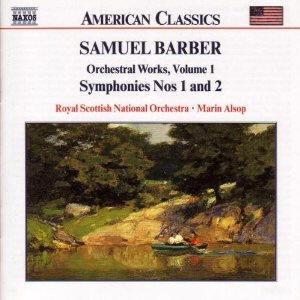|
You are reading the older HTML site
Positive Feedback ISSUE 60
Barber, Symphonies: No. 1, Op. 9; No. 2, Op. 19.
The School for Scandal: Overture, Op. 5. First
Essay for Orchestra, Op. 12
Royal Scottish National Orchestra/Marin Alsop, Naxos 8.559024. TT: 69.47. mp3 Downloads: VBR from Amazon.com. The program is handy, bringing Barber's two symphonies together with the First Essay—definitely the best of his three, the other two suffering from "sequelitis"—and the overture to The School for Scandal. But, despite sensitive, intelligent leadership from a rising American conductor, the orchestral performances aren't quite idiomatic. During Neeme Järvi's extended directorship, the Royal Scottish National Orchestra developed a rich tone and an expressive way with a broad lyric line. But, since the conductor's interpretations emphasized warmth and "spontaneity" rather than precision for its own sake, the ensemble's sound could also turn bassy, and generalized in texture. This style of playing could produce pleasing and even impressive results, but it's arguably out of place in music that calls for rhythmic snap and for clarity among a variety of moving parts. Thus, the School for Scandal overture—still an incomprehensibly underrated showpiece—begins with a nice dramatic energy, but shortly thereafter, the pulsing, syncopated brass chords are sluggish. They don't exactly get in the way, but neither do they propel the theme forward as they should; that sort of crispness simply doesn't come naturally to these players. The big sound better suits the grander musical gestures of the two symphonies. The warm tone is welcome in the lyric phrases of the First, but the sonorities thicken in the surging, active tuttis, though the playing as such is accurate enough. The same thing happens as the Andante tranquillo expands into a climax, though the long oboe solo is sensitive and intense, and the rhetorical breadth is persuasive. In the Second Symphony, in three movements rather than the First's condensed single movement, the woodwind playing has an appealing lightness. But the driving rhythms could use more point—the big string run at 9:53 of the opening Allegro ma non troppo, for example, is cautious and lumbering—and, again, the peak moments are portentous. The First Essay for Orchestra, on the other hand, receives one of its best recorded outings. Alsop begins with a sense of suspense and anticipation, building the piece in a long arc while acknowledging its sectional contrasts of texture, mood, and impulse. Here, too, the texture thickens at the climaxes, but it seems to matter less in the context of so heartfelt a reading. At Naxos prices—still budget-level in the U.S., I believe, although it's risen to mid-price in the U.K.—you might find this collection worth having, particularly for the First Essay. Still, it's too bad Alsop didn't get to record this music with an American ensemble. In fact, the Baltimore Symphony, Alsop's current orchestra, recorded the First Symphony twenty years ago with David Zinman (Argo), playing with a more transparent, tapered tone and a surer sense of style than the Scots. For a larger-scaled, more overtly "symphonic" performance, Leonard Slatkin's St. Louis account (RCA) is effective. Thomas Schippers's early-stereo rendition of the School for Scandal overture (Sony) is lively and colorful, although Lorin Maazel's dazzling Blossom Festival performance with the Cleveland Orchestra ought to be made commercially available.
|

